Big Data Analysis: Techniques, Challenges, and Support for Business
VerifiedAdded on 2023/06/14
|9
|2289
|93
Report
AI Summary
This report provides a comprehensive overview of big data, including its characteristics, challenges, and techniques for analysis. It defines big data as a combination of traditional and contemporary techniques for insightful data analysis, emphasizing the 'three V's' (volume, variety, and velocity) and additional features like value, veracity, and variability. The report identifies challenges such as a lack of skilled professionals, insufficient understanding of massive data, data growth issues, and data security. Various analytical techniques, including A/B testing, data fusion and integration, data mining, and machine learning, are discussed. Furthermore, the report illustrates how big data technology supports businesses, using Netflix and Amazon as examples of companies leveraging big data to improve service quality, personalize customer experiences, and drive sales. The report concludes that big data is essential for informed decision-making and that its tools and techniques are increasingly vital for businesses to analyze and interpret information effectively. Desklib provides access to this and similar solved assignments for students.

bmp4005
Paraphrase This Document
Need a fresh take? Get an instant paraphrase of this document with our AI Paraphraser
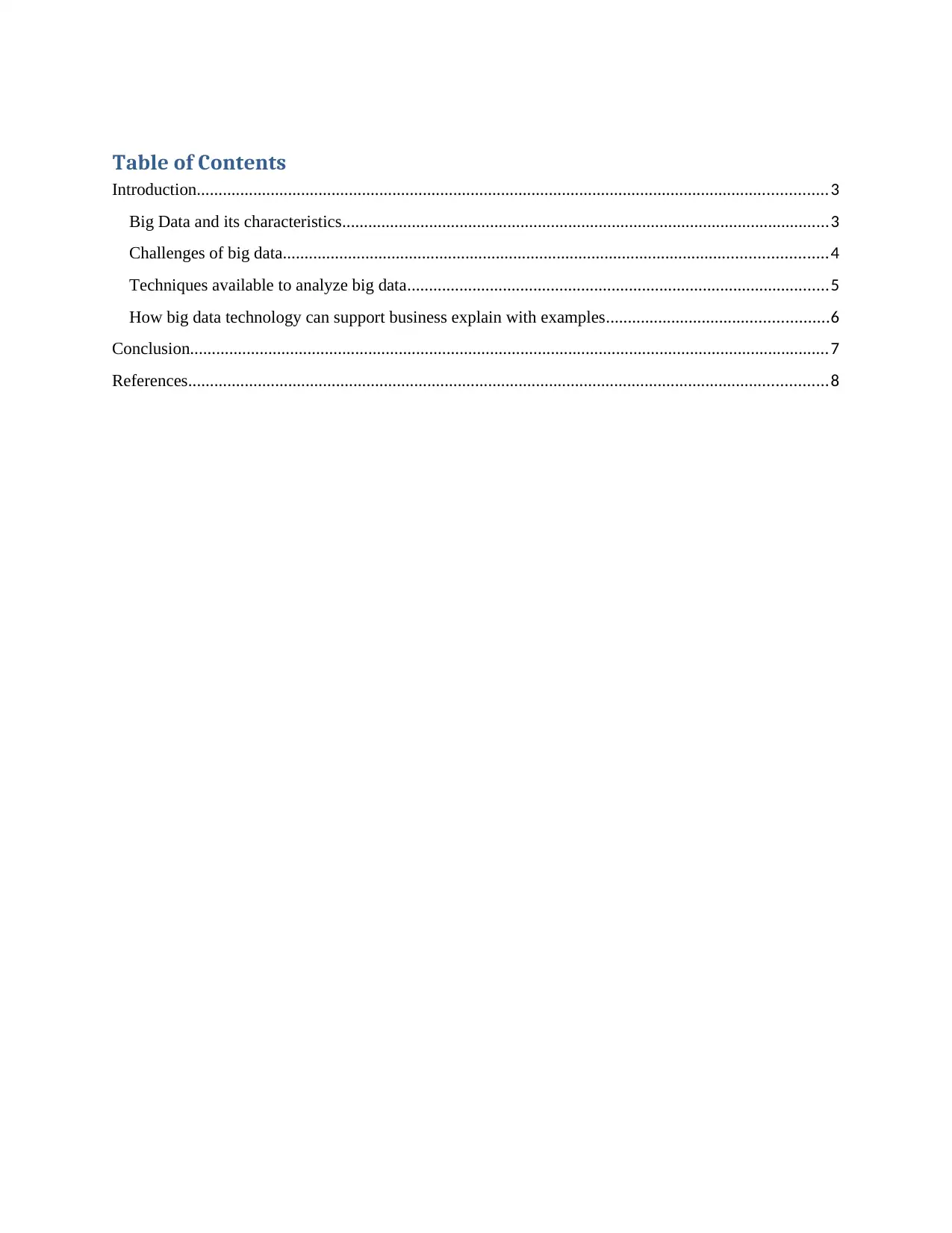
Table of Contents
Introduction.................................................................................................................................................3
Big Data and its characteristics................................................................................................................3
Challenges of big data.............................................................................................................................4
Techniques available to analyze big data.................................................................................................5
How big data technology can support business explain with examples...................................................6
Conclusion...................................................................................................................................................7
References...................................................................................................................................................8
Introduction.................................................................................................................................................3
Big Data and its characteristics................................................................................................................3
Challenges of big data.............................................................................................................................4
Techniques available to analyze big data.................................................................................................5
How big data technology can support business explain with examples...................................................6
Conclusion...................................................................................................................................................7
References...................................................................................................................................................8
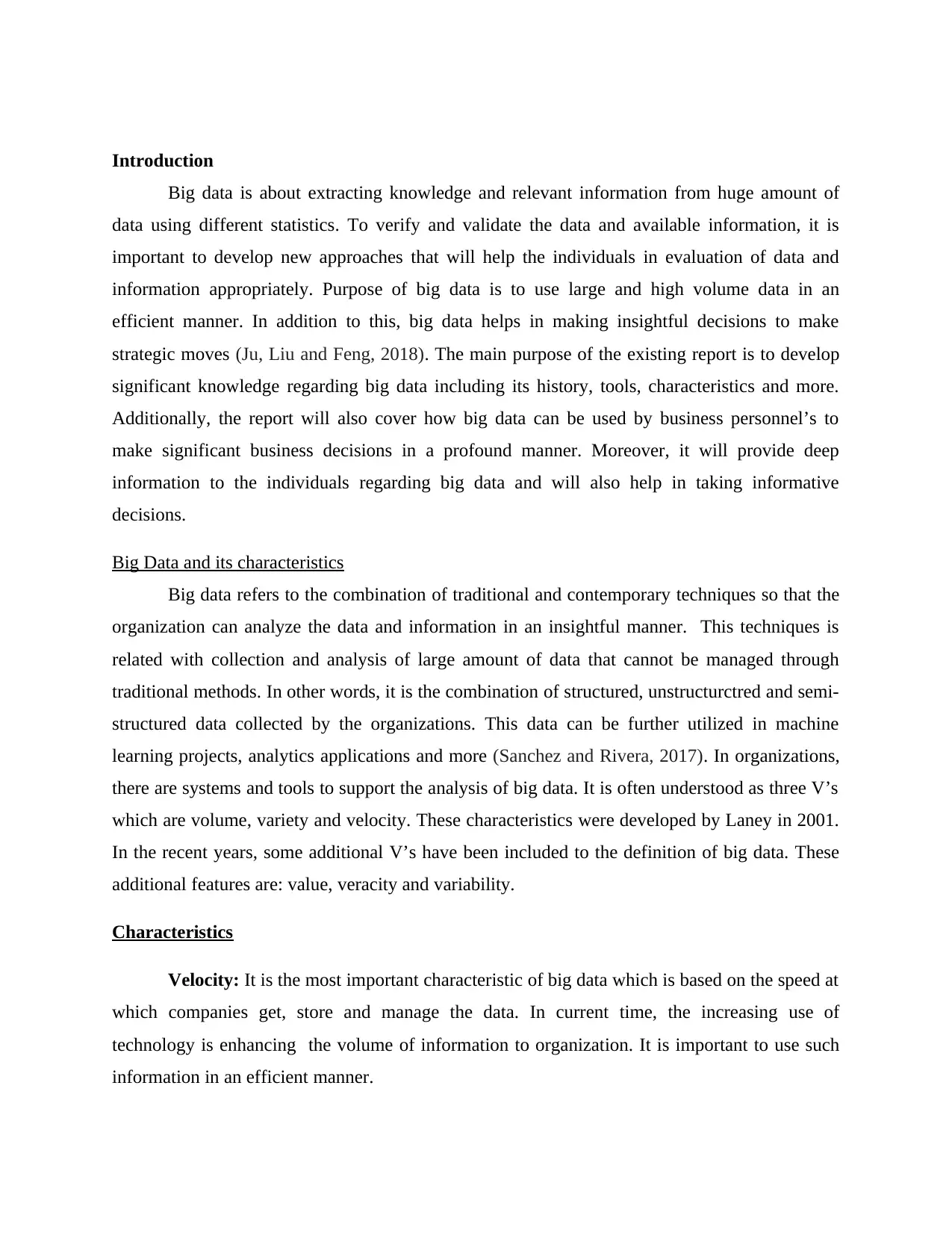
Introduction
Big data is about extracting knowledge and relevant information from huge amount of
data using different statistics. To verify and validate the data and available information, it is
important to develop new approaches that will help the individuals in evaluation of data and
information appropriately. Purpose of big data is to use large and high volume data in an
efficient manner. In addition to this, big data helps in making insightful decisions to make
strategic moves (Ju, Liu and Feng, 2018). The main purpose of the existing report is to develop
significant knowledge regarding big data including its history, tools, characteristics and more.
Additionally, the report will also cover how big data can be used by business personnel’s to
make significant business decisions in a profound manner. Moreover, it will provide deep
information to the individuals regarding big data and will also help in taking informative
decisions.
Big Data and its characteristics
Big data refers to the combination of traditional and contemporary techniques so that the
organization can analyze the data and information in an insightful manner. This techniques is
related with collection and analysis of large amount of data that cannot be managed through
traditional methods. In other words, it is the combination of structured, unstructurctred and semi-
structured data collected by the organizations. This data can be further utilized in machine
learning projects, analytics applications and more (Sanchez and Rivera, 2017). In organizations,
there are systems and tools to support the analysis of big data. It is often understood as three V’s
which are volume, variety and velocity. These characteristics were developed by Laney in 2001.
In the recent years, some additional V’s have been included to the definition of big data. These
additional features are: value, veracity and variability.
Characteristics
Velocity: It is the most important characteristic of big data which is based on the speed at
which companies get, store and manage the data. In current time, the increasing use of
technology is enhancing the volume of information to organization. It is important to use such
information in an efficient manner.
Big data is about extracting knowledge and relevant information from huge amount of
data using different statistics. To verify and validate the data and available information, it is
important to develop new approaches that will help the individuals in evaluation of data and
information appropriately. Purpose of big data is to use large and high volume data in an
efficient manner. In addition to this, big data helps in making insightful decisions to make
strategic moves (Ju, Liu and Feng, 2018). The main purpose of the existing report is to develop
significant knowledge regarding big data including its history, tools, characteristics and more.
Additionally, the report will also cover how big data can be used by business personnel’s to
make significant business decisions in a profound manner. Moreover, it will provide deep
information to the individuals regarding big data and will also help in taking informative
decisions.
Big Data and its characteristics
Big data refers to the combination of traditional and contemporary techniques so that the
organization can analyze the data and information in an insightful manner. This techniques is
related with collection and analysis of large amount of data that cannot be managed through
traditional methods. In other words, it is the combination of structured, unstructurctred and semi-
structured data collected by the organizations. This data can be further utilized in machine
learning projects, analytics applications and more (Sanchez and Rivera, 2017). In organizations,
there are systems and tools to support the analysis of big data. It is often understood as three V’s
which are volume, variety and velocity. These characteristics were developed by Laney in 2001.
In the recent years, some additional V’s have been included to the definition of big data. These
additional features are: value, veracity and variability.
Characteristics
Velocity: It is the most important characteristic of big data which is based on the speed at
which companies get, store and manage the data. In current time, the increasing use of
technology is enhancing the volume of information to organization. It is important to use such
information in an efficient manner.
⊘ This is a preview!⊘
Do you want full access?
Subscribe today to unlock all pages.

Trusted by 1+ million students worldwide
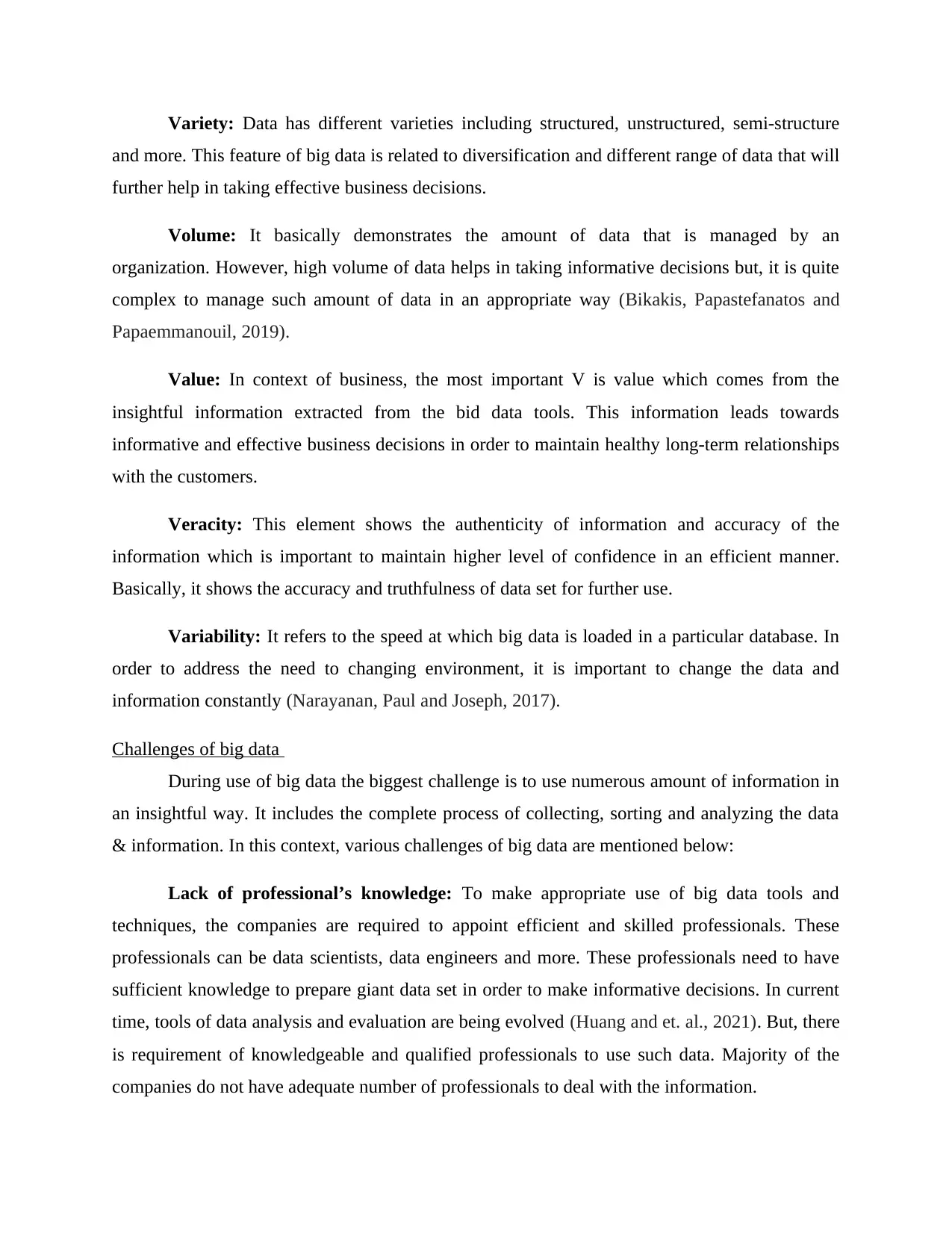
Variety: Data has different varieties including structured, unstructured, semi-structure
and more. This feature of big data is related to diversification and different range of data that will
further help in taking effective business decisions.
Volume: It basically demonstrates the amount of data that is managed by an
organization. However, high volume of data helps in taking informative decisions but, it is quite
complex to manage such amount of data in an appropriate way (Bikakis, Papastefanatos and
Papaemmanouil, 2019).
Value: In context of business, the most important V is value which comes from the
insightful information extracted from the bid data tools. This information leads towards
informative and effective business decisions in order to maintain healthy long-term relationships
with the customers.
Veracity: This element shows the authenticity of information and accuracy of the
information which is important to maintain higher level of confidence in an efficient manner.
Basically, it shows the accuracy and truthfulness of data set for further use.
Variability: It refers to the speed at which big data is loaded in a particular database. In
order to address the need to changing environment, it is important to change the data and
information constantly (Narayanan, Paul and Joseph, 2017).
Challenges of big data
During use of big data the biggest challenge is to use numerous amount of information in
an insightful way. It includes the complete process of collecting, sorting and analyzing the data
& information. In this context, various challenges of big data are mentioned below:
Lack of professional’s knowledge: To make appropriate use of big data tools and
techniques, the companies are required to appoint efficient and skilled professionals. These
professionals can be data scientists, data engineers and more. These professionals need to have
sufficient knowledge to prepare giant data set in order to make informative decisions. In current
time, tools of data analysis and evaluation are being evolved (Huang and et. al., 2021). But, there
is requirement of knowledgeable and qualified professionals to use such data. Majority of the
companies do not have adequate number of professionals to deal with the information.
and more. This feature of big data is related to diversification and different range of data that will
further help in taking effective business decisions.
Volume: It basically demonstrates the amount of data that is managed by an
organization. However, high volume of data helps in taking informative decisions but, it is quite
complex to manage such amount of data in an appropriate way (Bikakis, Papastefanatos and
Papaemmanouil, 2019).
Value: In context of business, the most important V is value which comes from the
insightful information extracted from the bid data tools. This information leads towards
informative and effective business decisions in order to maintain healthy long-term relationships
with the customers.
Veracity: This element shows the authenticity of information and accuracy of the
information which is important to maintain higher level of confidence in an efficient manner.
Basically, it shows the accuracy and truthfulness of data set for further use.
Variability: It refers to the speed at which big data is loaded in a particular database. In
order to address the need to changing environment, it is important to change the data and
information constantly (Narayanan, Paul and Joseph, 2017).
Challenges of big data
During use of big data the biggest challenge is to use numerous amount of information in
an insightful way. It includes the complete process of collecting, sorting and analyzing the data
& information. In this context, various challenges of big data are mentioned below:
Lack of professional’s knowledge: To make appropriate use of big data tools and
techniques, the companies are required to appoint efficient and skilled professionals. These
professionals can be data scientists, data engineers and more. These professionals need to have
sufficient knowledge to prepare giant data set in order to make informative decisions. In current
time, tools of data analysis and evaluation are being evolved (Huang and et. al., 2021). But, there
is requirement of knowledgeable and qualified professionals to use such data. Majority of the
companies do not have adequate number of professionals to deal with the information.
Paraphrase This Document
Need a fresh take? Get an instant paraphrase of this document with our AI Paraphraser
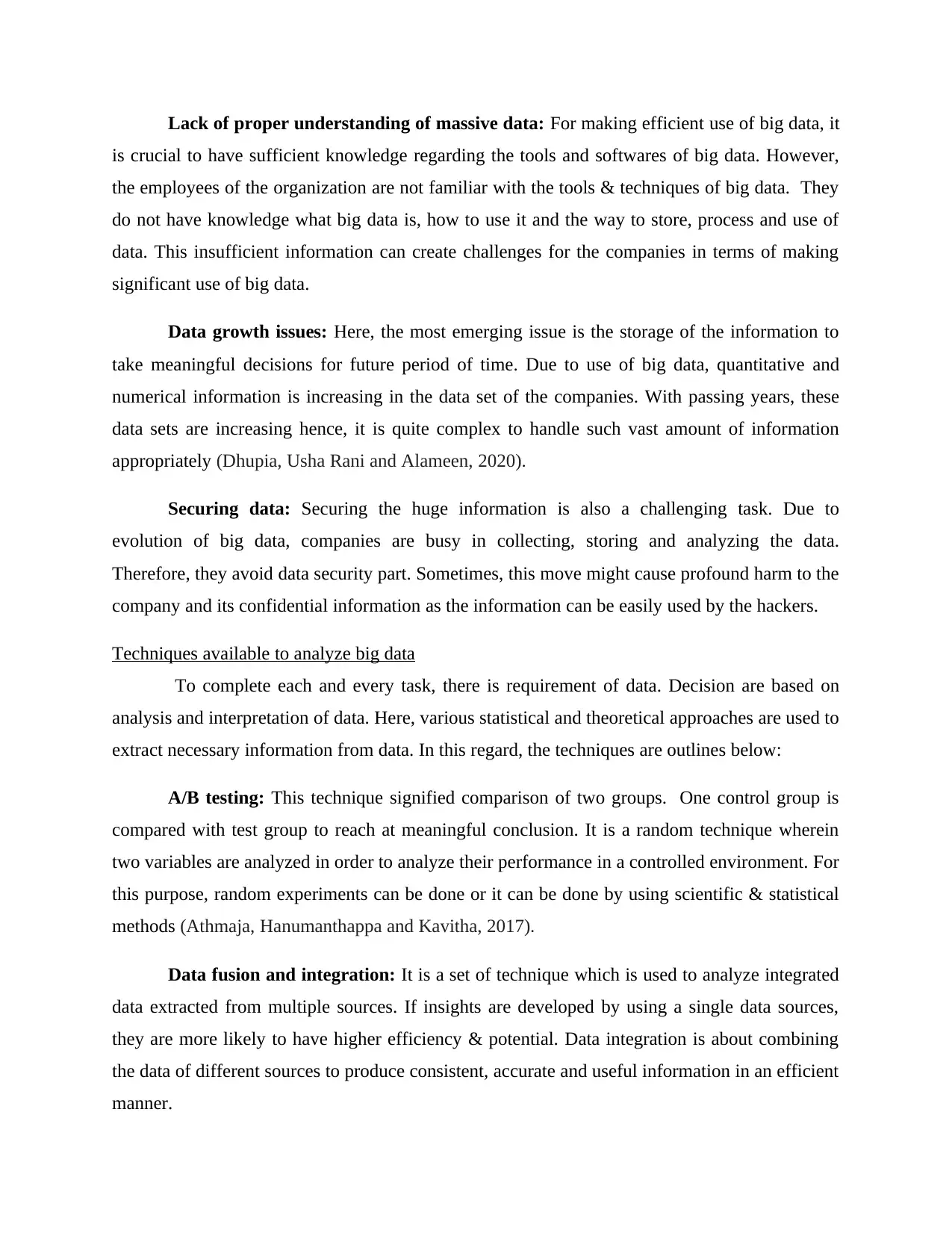
Lack of proper understanding of massive data: For making efficient use of big data, it
is crucial to have sufficient knowledge regarding the tools and softwares of big data. However,
the employees of the organization are not familiar with the tools & techniques of big data. They
do not have knowledge what big data is, how to use it and the way to store, process and use of
data. This insufficient information can create challenges for the companies in terms of making
significant use of big data.
Data growth issues: Here, the most emerging issue is the storage of the information to
take meaningful decisions for future period of time. Due to use of big data, quantitative and
numerical information is increasing in the data set of the companies. With passing years, these
data sets are increasing hence, it is quite complex to handle such vast amount of information
appropriately (Dhupia, Usha Rani and Alameen, 2020).
Securing data: Securing the huge information is also a challenging task. Due to
evolution of big data, companies are busy in collecting, storing and analyzing the data.
Therefore, they avoid data security part. Sometimes, this move might cause profound harm to the
company and its confidential information as the information can be easily used by the hackers.
Techniques available to analyze big data
To complete each and every task, there is requirement of data. Decision are based on
analysis and interpretation of data. Here, various statistical and theoretical approaches are used to
extract necessary information from data. In this regard, the techniques are outlines below:
A/B testing: This technique signified comparison of two groups. One control group is
compared with test group to reach at meaningful conclusion. It is a random technique wherein
two variables are analyzed in order to analyze their performance in a controlled environment. For
this purpose, random experiments can be done or it can be done by using scientific & statistical
methods (Athmaja, Hanumanthappa and Kavitha, 2017).
Data fusion and integration: It is a set of technique which is used to analyze integrated
data extracted from multiple sources. If insights are developed by using a single data sources,
they are more likely to have higher efficiency & potential. Data integration is about combining
the data of different sources to produce consistent, accurate and useful information in an efficient
manner.
is crucial to have sufficient knowledge regarding the tools and softwares of big data. However,
the employees of the organization are not familiar with the tools & techniques of big data. They
do not have knowledge what big data is, how to use it and the way to store, process and use of
data. This insufficient information can create challenges for the companies in terms of making
significant use of big data.
Data growth issues: Here, the most emerging issue is the storage of the information to
take meaningful decisions for future period of time. Due to use of big data, quantitative and
numerical information is increasing in the data set of the companies. With passing years, these
data sets are increasing hence, it is quite complex to handle such vast amount of information
appropriately (Dhupia, Usha Rani and Alameen, 2020).
Securing data: Securing the huge information is also a challenging task. Due to
evolution of big data, companies are busy in collecting, storing and analyzing the data.
Therefore, they avoid data security part. Sometimes, this move might cause profound harm to the
company and its confidential information as the information can be easily used by the hackers.
Techniques available to analyze big data
To complete each and every task, there is requirement of data. Decision are based on
analysis and interpretation of data. Here, various statistical and theoretical approaches are used to
extract necessary information from data. In this regard, the techniques are outlines below:
A/B testing: This technique signified comparison of two groups. One control group is
compared with test group to reach at meaningful conclusion. It is a random technique wherein
two variables are analyzed in order to analyze their performance in a controlled environment. For
this purpose, random experiments can be done or it can be done by using scientific & statistical
methods (Athmaja, Hanumanthappa and Kavitha, 2017).
Data fusion and integration: It is a set of technique which is used to analyze integrated
data extracted from multiple sources. If insights are developed by using a single data sources,
they are more likely to have higher efficiency & potential. Data integration is about combining
the data of different sources to produce consistent, accurate and useful information in an efficient
manner.
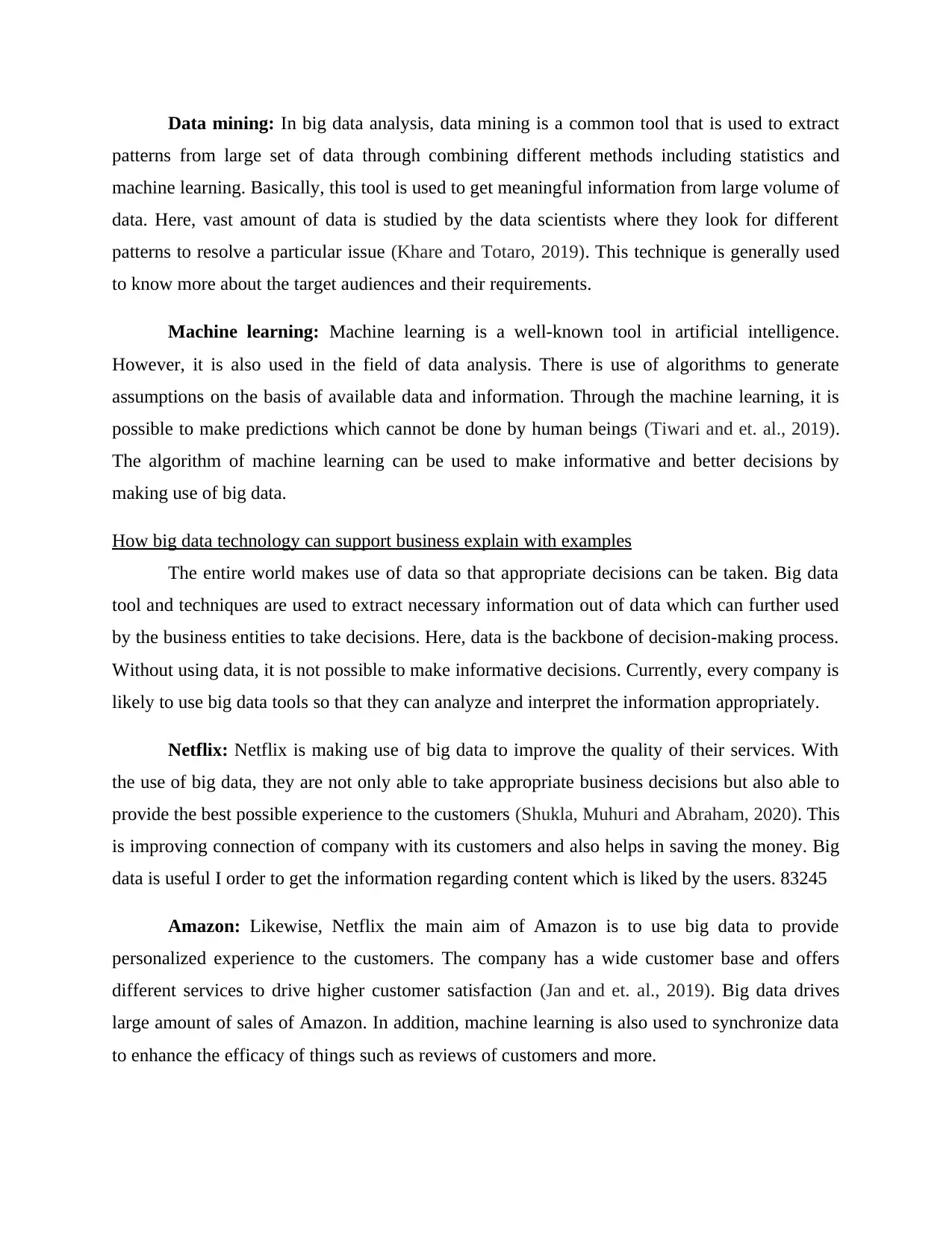
Data mining: In big data analysis, data mining is a common tool that is used to extract
patterns from large set of data through combining different methods including statistics and
machine learning. Basically, this tool is used to get meaningful information from large volume of
data. Here, vast amount of data is studied by the data scientists where they look for different
patterns to resolve a particular issue (Khare and Totaro, 2019). This technique is generally used
to know more about the target audiences and their requirements.
Machine learning: Machine learning is a well-known tool in artificial intelligence.
However, it is also used in the field of data analysis. There is use of algorithms to generate
assumptions on the basis of available data and information. Through the machine learning, it is
possible to make predictions which cannot be done by human beings (Tiwari and et. al., 2019).
The algorithm of machine learning can be used to make informative and better decisions by
making use of big data.
How big data technology can support business explain with examples
The entire world makes use of data so that appropriate decisions can be taken. Big data
tool and techniques are used to extract necessary information out of data which can further used
by the business entities to take decisions. Here, data is the backbone of decision-making process.
Without using data, it is not possible to make informative decisions. Currently, every company is
likely to use big data tools so that they can analyze and interpret the information appropriately.
Netflix: Netflix is making use of big data to improve the quality of their services. With
the use of big data, they are not only able to take appropriate business decisions but also able to
provide the best possible experience to the customers (Shukla, Muhuri and Abraham, 2020). This
is improving connection of company with its customers and also helps in saving the money. Big
data is useful I order to get the information regarding content which is liked by the users. 83245
Amazon: Likewise, Netflix the main aim of Amazon is to use big data to provide
personalized experience to the customers. The company has a wide customer base and offers
different services to drive higher customer satisfaction (Jan and et. al., 2019). Big data drives
large amount of sales of Amazon. In addition, machine learning is also used to synchronize data
to enhance the efficacy of things such as reviews of customers and more.
patterns from large set of data through combining different methods including statistics and
machine learning. Basically, this tool is used to get meaningful information from large volume of
data. Here, vast amount of data is studied by the data scientists where they look for different
patterns to resolve a particular issue (Khare and Totaro, 2019). This technique is generally used
to know more about the target audiences and their requirements.
Machine learning: Machine learning is a well-known tool in artificial intelligence.
However, it is also used in the field of data analysis. There is use of algorithms to generate
assumptions on the basis of available data and information. Through the machine learning, it is
possible to make predictions which cannot be done by human beings (Tiwari and et. al., 2019).
The algorithm of machine learning can be used to make informative and better decisions by
making use of big data.
How big data technology can support business explain with examples
The entire world makes use of data so that appropriate decisions can be taken. Big data
tool and techniques are used to extract necessary information out of data which can further used
by the business entities to take decisions. Here, data is the backbone of decision-making process.
Without using data, it is not possible to make informative decisions. Currently, every company is
likely to use big data tools so that they can analyze and interpret the information appropriately.
Netflix: Netflix is making use of big data to improve the quality of their services. With
the use of big data, they are not only able to take appropriate business decisions but also able to
provide the best possible experience to the customers (Shukla, Muhuri and Abraham, 2020). This
is improving connection of company with its customers and also helps in saving the money. Big
data is useful I order to get the information regarding content which is liked by the users. 83245
Amazon: Likewise, Netflix the main aim of Amazon is to use big data to provide
personalized experience to the customers. The company has a wide customer base and offers
different services to drive higher customer satisfaction (Jan and et. al., 2019). Big data drives
large amount of sales of Amazon. In addition, machine learning is also used to synchronize data
to enhance the efficacy of things such as reviews of customers and more.
⊘ This is a preview!⊘
Do you want full access?
Subscribe today to unlock all pages.

Trusted by 1+ million students worldwide

Conclusion
Through the above-discussion, it is analyzed that big data refers to large amount of data
that is used to take suitable business related decisions. The big data has different characterstics in
terms of velocity, volume, variety and more. Additionally, there is discussion regarding the
challenges of big data and techniques and tools of big data. Further, big data can also be used by
the business organization to support decision making.
Through the above-discussion, it is analyzed that big data refers to large amount of data
that is used to take suitable business related decisions. The big data has different characterstics in
terms of velocity, volume, variety and more. Additionally, there is discussion regarding the
challenges of big data and techniques and tools of big data. Further, big data can also be used by
the business organization to support decision making.
Paraphrase This Document
Need a fresh take? Get an instant paraphrase of this document with our AI Paraphraser
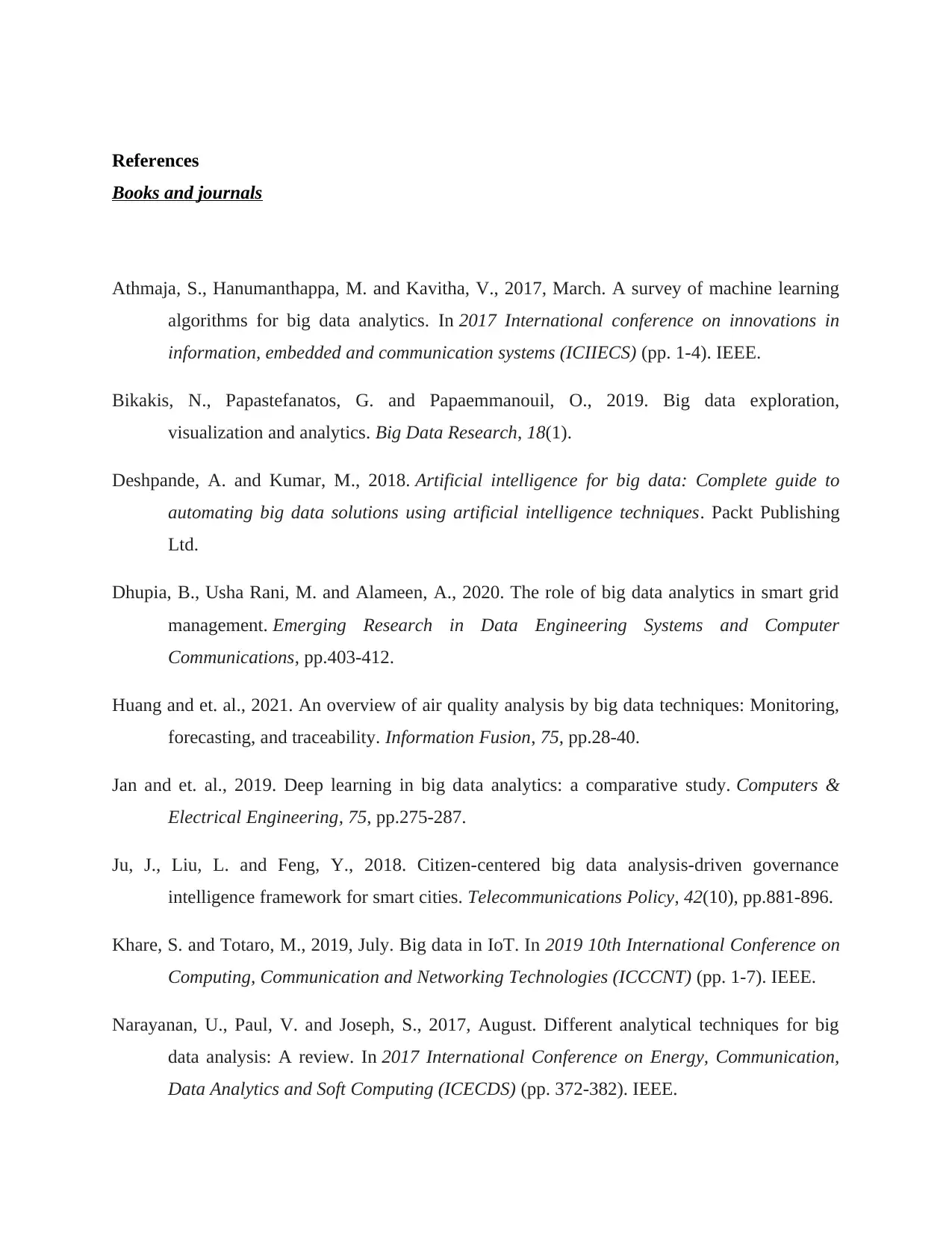
References
Books and journals
Athmaja, S., Hanumanthappa, M. and Kavitha, V., 2017, March. A survey of machine learning
algorithms for big data analytics. In 2017 International conference on innovations in
information, embedded and communication systems (ICIIECS) (pp. 1-4). IEEE.
Bikakis, N., Papastefanatos, G. and Papaemmanouil, O., 2019. Big data exploration,
visualization and analytics. Big Data Research, 18(1).
Deshpande, A. and Kumar, M., 2018. Artificial intelligence for big data: Complete guide to
automating big data solutions using artificial intelligence techniques. Packt Publishing
Ltd.
Dhupia, B., Usha Rani, M. and Alameen, A., 2020. The role of big data analytics in smart grid
management. Emerging Research in Data Engineering Systems and Computer
Communications, pp.403-412.
Huang and et. al., 2021. An overview of air quality analysis by big data techniques: Monitoring,
forecasting, and traceability. Information Fusion, 75, pp.28-40.
Jan and et. al., 2019. Deep learning in big data analytics: a comparative study. Computers &
Electrical Engineering, 75, pp.275-287.
Ju, J., Liu, L. and Feng, Y., 2018. Citizen-centered big data analysis-driven governance
intelligence framework for smart cities. Telecommunications Policy, 42(10), pp.881-896.
Khare, S. and Totaro, M., 2019, July. Big data in IoT. In 2019 10th International Conference on
Computing, Communication and Networking Technologies (ICCCNT) (pp. 1-7). IEEE.
Narayanan, U., Paul, V. and Joseph, S., 2017, August. Different analytical techniques for big
data analysis: A review. In 2017 International Conference on Energy, Communication,
Data Analytics and Soft Computing (ICECDS) (pp. 372-382). IEEE.
Books and journals
Athmaja, S., Hanumanthappa, M. and Kavitha, V., 2017, March. A survey of machine learning
algorithms for big data analytics. In 2017 International conference on innovations in
information, embedded and communication systems (ICIIECS) (pp. 1-4). IEEE.
Bikakis, N., Papastefanatos, G. and Papaemmanouil, O., 2019. Big data exploration,
visualization and analytics. Big Data Research, 18(1).
Deshpande, A. and Kumar, M., 2018. Artificial intelligence for big data: Complete guide to
automating big data solutions using artificial intelligence techniques. Packt Publishing
Ltd.
Dhupia, B., Usha Rani, M. and Alameen, A., 2020. The role of big data analytics in smart grid
management. Emerging Research in Data Engineering Systems and Computer
Communications, pp.403-412.
Huang and et. al., 2021. An overview of air quality analysis by big data techniques: Monitoring,
forecasting, and traceability. Information Fusion, 75, pp.28-40.
Jan and et. al., 2019. Deep learning in big data analytics: a comparative study. Computers &
Electrical Engineering, 75, pp.275-287.
Ju, J., Liu, L. and Feng, Y., 2018. Citizen-centered big data analysis-driven governance
intelligence framework for smart cities. Telecommunications Policy, 42(10), pp.881-896.
Khare, S. and Totaro, M., 2019, July. Big data in IoT. In 2019 10th International Conference on
Computing, Communication and Networking Technologies (ICCCNT) (pp. 1-7). IEEE.
Narayanan, U., Paul, V. and Joseph, S., 2017, August. Different analytical techniques for big
data analysis: A review. In 2017 International Conference on Energy, Communication,
Data Analytics and Soft Computing (ICECDS) (pp. 372-382). IEEE.
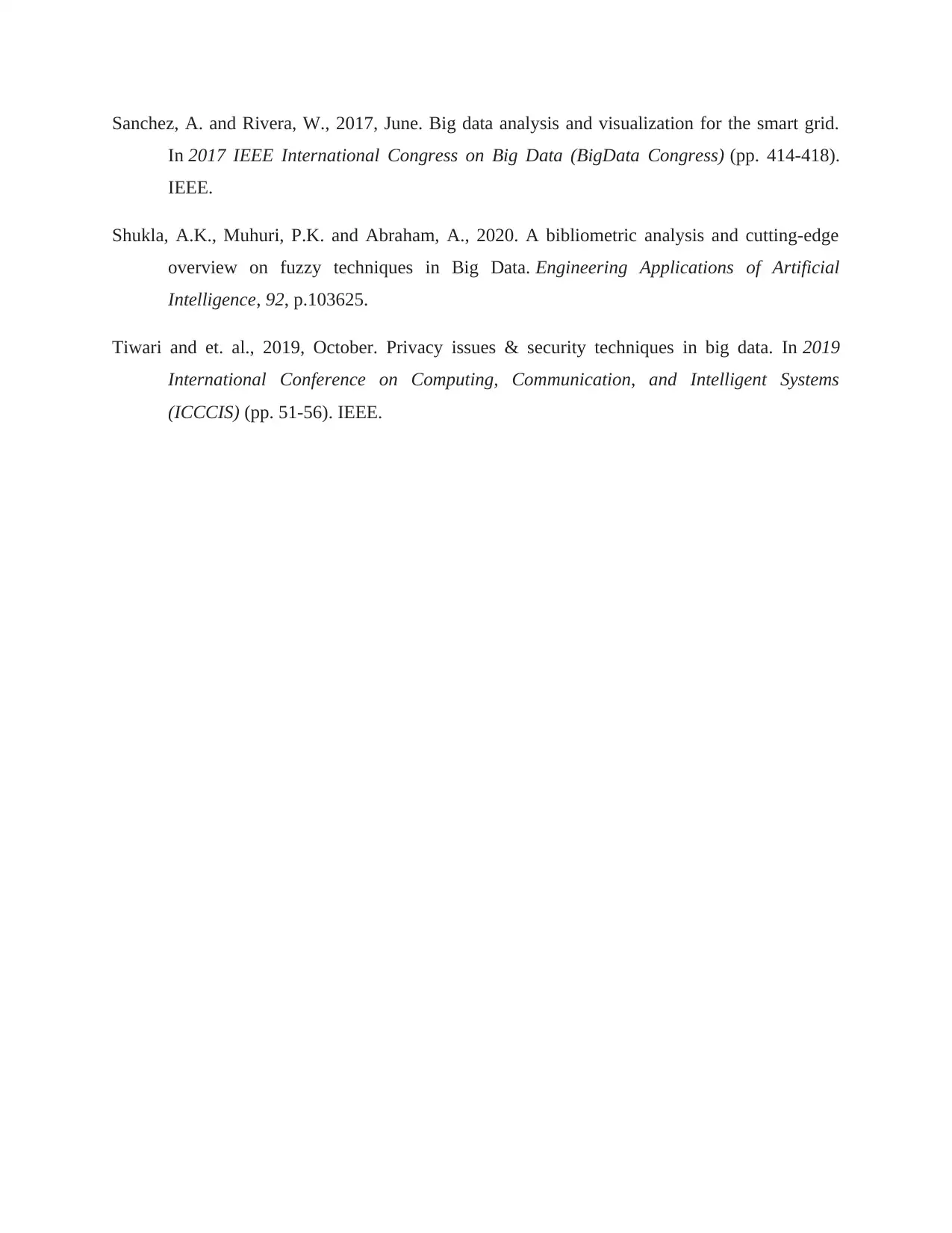
Sanchez, A. and Rivera, W., 2017, June. Big data analysis and visualization for the smart grid.
In 2017 IEEE International Congress on Big Data (BigData Congress) (pp. 414-418).
IEEE.
Shukla, A.K., Muhuri, P.K. and Abraham, A., 2020. A bibliometric analysis and cutting-edge
overview on fuzzy techniques in Big Data. Engineering Applications of Artificial
Intelligence, 92, p.103625.
Tiwari and et. al., 2019, October. Privacy issues & security techniques in big data. In 2019
International Conference on Computing, Communication, and Intelligent Systems
(ICCCIS) (pp. 51-56). IEEE.
In 2017 IEEE International Congress on Big Data (BigData Congress) (pp. 414-418).
IEEE.
Shukla, A.K., Muhuri, P.K. and Abraham, A., 2020. A bibliometric analysis and cutting-edge
overview on fuzzy techniques in Big Data. Engineering Applications of Artificial
Intelligence, 92, p.103625.
Tiwari and et. al., 2019, October. Privacy issues & security techniques in big data. In 2019
International Conference on Computing, Communication, and Intelligent Systems
(ICCCIS) (pp. 51-56). IEEE.
⊘ This is a preview!⊘
Do you want full access?
Subscribe today to unlock all pages.

Trusted by 1+ million students worldwide
1 out of 9
Related Documents
Your All-in-One AI-Powered Toolkit for Academic Success.
+13062052269
info@desklib.com
Available 24*7 on WhatsApp / Email
![[object Object]](/_next/static/media/star-bottom.7253800d.svg)
Unlock your academic potential
Copyright © 2020–2025 A2Z Services. All Rights Reserved. Developed and managed by ZUCOL.



